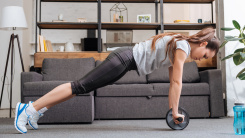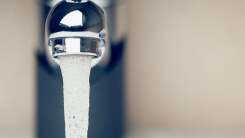These Are the Most Effective Ab Exercises

Do you want a strong core, and maybe a chance of developing a six-pack? Adding some ab isolation exercises will help you target that area. Read on, and I’ll explain the best exercises, the best strategies for training, and what ab training can and cannot do for you—since there are so many myths about this.
Where your ab muscles are and what they do
“Ab” is short for abdominals, and usually refers to a muscle called the rectus abdominis (RA for short).
The RA is a long, vertical muscle on the front of your body that connects your pelvis to your ribcage. When you contract it, the front of your pelvis moves closer to the front of your ribcage. (This is what happens when you do a crunch.)
The RA has some horizontal lines of connective tissue, which are what split the muscle into its so-called “six pack,” but the number and shape of those segments varies from person to person. Arnold Schwarzennegger famously only has a four-pack, and Kumail Nanjiani famously has asymmetrical abs. All of these variations are normal, and you can’t change your muscle structure—only its size and strength.
Instead of talking about “ab” training, it’s more common these days to talk about “core” training. Your core includes a bunch of other muscles besides the RA. There’s your transverse abdominis, your internal and external obliques, a variety of back muscles including your spinal erectors, and some trainers consider the glutes, hip flexors, upper back, and chest muscles when they talk about the core. So core training isn’t just ab training, but strong abs contribute to a strong core.
Why planks and situps are not the best ab exercises
The classic ab exercises are situps and planks. Neither is a bad exercise, but you can do better.
The main problem with situps is that if you push for more reps after your abs are fatigued, other muscles take over that can end up pulling on your spine and causing back pain. This isn’t an issue if you do, say, sets of 10 situps, and stop while you still have a few good-form reps in the tank. But if you’re doing tons of them, this can lead to an achy back.
When situps fell out of favor, planks became the new favorite. On the bright side, they tend to be easier on the back and they work more core muscles than just your RA. But planks are tough for beginners, and once you’re more advanced, they are a dead-end exercise. Once you can hold a plank for a minute or so, they’re not challenging your strength very much. Nobody cares if you can hold a plank for two minutes, or three, or ten. I mean, it’s impressive, but there are better ways to strengthen your core.
The best ab exercise for absolute beginners: deadbugs
window.videoEmbeds = window.videoEmbeds || []; window.videoEmbeds.push({
elemId: ‘video-container-TMcyXmXeFyk’,
data: {“slug”:”TMcyXmXeFyk”,”start_time”:null,”url”:”https://www.youtube.com/watch?v=TMcyXmXeFyk”},
videoPlayerType: ‘in-content’
});
If your back hurts or your hips sag when you do planks or pushups, deadbugs are the perfect exercise for you. In this exercise, you lie on your back, all four limbs in the air (hence the name), and you slowly lower one arm and one leg toward the ground while keeping your torso steady.
If even that is too hard—which it is, for a lot of beginners!—you can regress the exercise by only doing one arm at a time, or by keeping your legs bent. Once you can do deadbugs with good form with straight arms and legs at the same time, you’re ready to move on to other exercises.
The best ab exercise for people who are sick of planks: ab rollouts
The humble ab wheel is fantastically challenging for your core, as you’ll know if you ever saw one in the corner of the gym, went “oh hey, what’s this?” and then promptly fell on your face.
To train more productively with the ab wheel, set up so that you’re kneeling, and facing a wall. Roll the wheel into the wall, then roll it back to your starting position, trying not to use your hips. Aim for a distance that lets you do three sets of 8-12 reps.
As you get better at it, you’ll be able to move farther away from the wall. The ultimate goal is to go all the way out until your belly touches the floor, and back up—and then to do that while standing, not kneeling.
To do this exercise, you’ll need an ab wheel, but don’t overthink it—a basic $10 one will do great. In fact, the cheaper ones tend to be better, since they’re less stable, making you engage your core even more.
Honorable mentions
There are tons of great ab exercises, but I’d like to flag two of them. Plank saws are a great upgrade from regular planks. You rock your body back and forth, maintaining tension in your abs the whole time. You can do this either by flexing and extending your ankles, or by putting sliders under your feet.
Hanging leg raises are another great exercise for folks who are more advanced. The most difficult variation is to do them strict, without swinging, and with your legs straight. Hanging leg raises (with bent knees if needed) are a great alternative to the ab wheel if you don’t have an ab wheel.
Lightning round: all your questions about ab training, answered
Now that you have your ab exercise picked out, I’d like to address a few questions and myths.
Which ab exercises are best for men and for women?
That’s a trick question! You choose an appropriate ab exercise based on your current strength level, not on your gender or aesthetic goals. The best ab exercises for men and the best ab exercises for women are the same list of exercises.
How often should I train my abs?
Some people say you should train abs every day, and some recommend training them “like any other muscle” with a few hard sets a few times a week. The truth is that abs are like any other muscle, and that both approaches work. (You could choose to do squats or bicep curls every day if you wanted, but you’d have to keep them light.)
If you like to train abs every day, you can keep doing that. But I’d recommend hitting them for something like three to five sets of 10, two to three times a week. That should give those muscles enough rest that they’re up for a challenge when you do train them. You might find that you have a stronger core than you realized.
How do I get a six pack?
A “six pack” is what you get when your abs are big enough, and the amount of fat on your belly is low enough, that you can see some ab definition when you flex.
Even if you have a very strong core, your belly fat is what determines whether your abs are visible. And we all carry our fat differently: some people have a relatively easy time getting their abs to show, while others would need to be at an unhealthily low body fat percentage to achieve that.
If you want to get a six pack, you’ll need to train your abs, eat fewer calories than you burn, and be lucky in terms of your genetics and other uncontrollable factors.
Will these exercises make me lose belly fat?
Louder for the folks in the back: exercises do not make you lose fat in specific places. You can train a muscle (such as your RA) to make it bigger, and you can alter your diet to lose or gain fat overall. That’s it, those are the two levers you can pull. Doing deadbugs or ab rollouts or crunches or planks will not affect the amount of fat on your belly.
They will not “tone” your belly either; that’s just a code word for “building muscle and reducing fat,” which we discussed a moment ago. But these exercises will make your ab muscles stronger, which will help you to be a more athletic, functional, and healthier person. And that makes them, for many of us, worth doing.



